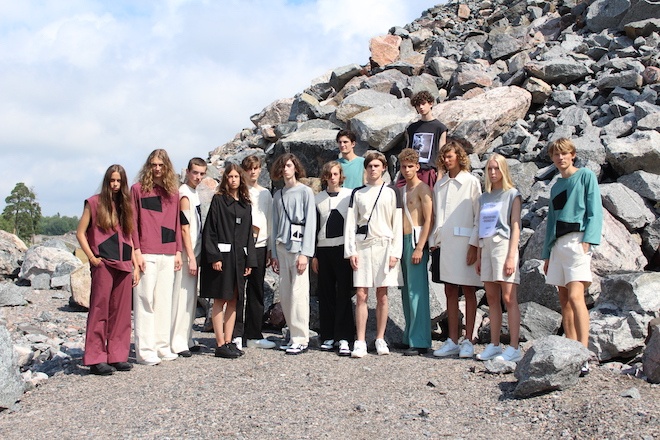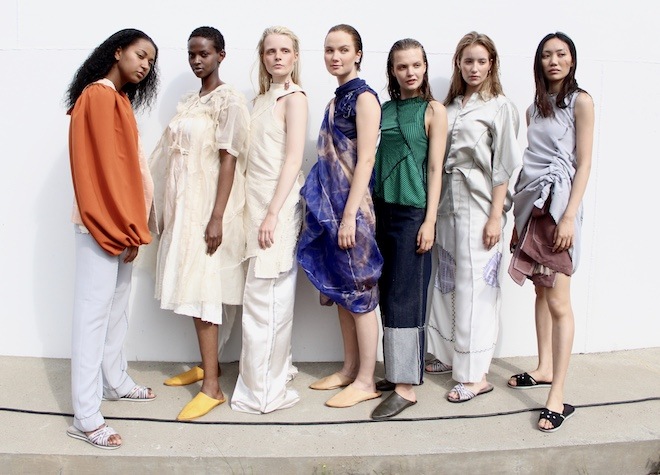Helsinki Fashion Week, now in its third year, is comprised of local and international brands who present their collections at the annual event. This year’s guest designers hailed from Italy, the Philippines, and Sweden, amongst other nations.
The common thread linking the brands is a sustainable approach. The event took place in a former oil silo, Öljysäiliö 468, on the outskirts of the city. The founder, Evelyn Mora told me, “the goal is to change the mindsets of people who work in the fashion industry about sustainability. We want to introduce sustainability not as a niche or a trend but as a true must, and not only in the fashion industry but in all the industries.”
The vast majority of designers that showed in Helsinki this year have yet to synergise sustainable practice with creativity. However those who placed creativity ahead of sustainability were the ones worth paying attention to.
These designers exhibited a prowess for craftsmanship, a discernible design signature and potential for future development. We hope to see much more of them in the seasons ahead.
_ _ _
Carl Jan Cruz (The Philippines)
When Carl Jan Cruz took his bow, the rapturous applause spoke for itself: it was a tremendous show.
The Filipino designer, whose work is currently sold at Maryam Nassir Zadeh in New York, conjured a distinctive mirage of Manila, the capital of the Philippines. He focused on artisanal craftsmanship, connecting it with a Manilan sensibility. It was an artful display replete with intricate embroideries, beautifully juxtaposed patterns, airy silhouettes, and patchwork. It was characterised by an uncomplicated effervescence but the cut of the fabric was distinctive, playing on asymmetry and obscure shapes.
Furthermore, Cruz’s diverse cast included models, family, and friends. The casting was celebratory of age, ethnicity, and gender. The casting felt organic, and not an attempt at baiting Instagram likes and articles centred on diversity.

Carl Jan Cruz
_ _ _
Airvei (France)
Julien Goulard’s Airvei (pronounced “airway”), a streetwear brand, reminded this writer of A-COLD-WALL* for its sociological exploration and poetic aspirations. Both men also come from other disciplines—Ross’ background is in graphic design, Goulard’s is in architecture and fine art. Fashion came second.
Goulard’s gambit is an ethical approach. He toyed with upcycled airbags and collaborated with ethical footwear brand Rombaut to create a collection which married form and function.
Streetwear is stagnating which is why it takes someone like Goulard to experiment with some new shapes. Amidst the sea of Off-White and Vetements, to distinguish oneself is a difficult challenge but Goulard’s work was a welcome addition amongst the more familiar tropes. Perhaps denizens of the streetwear world should look to Airvei its eco-friendly approach instead of other labels that bastardise the archive of Helmut Lang and call it their own. It was a generally accomplished outing from the Frenchman.

Airvei
_ _ _
N&S Gaia (India)
“I like to push the boundaries of the feminine silhouette,” said Sidarth Sinha, the New Delhi-based designer behind N&S Gaia, whose womenswear is defined by surrealist shapes and feminine touches. Ruffles were a dominant motif throughout the show, undulating as the models strutted past. The way they were cut was rather strange but it was exciting.
He superimposed images of sculpture and architecture into digital prints on the dresses which added a necessary secondary plot point. Sinha, who traveled to Italy for a fashion prize ceremony, before Berlin and Helsinki for fashion week, will be presenting at London Fashion Week in September. One hopes he can expand his dialogue in time.
_ _ _
Ellinor Brännström (Sweden)
Streetwear is rooted in masculinity but Swedish designer Ellinor Brännström is sending tremors throughout the landscape with work that deconstructs gender conformity: there were lace bicycle shorts, architectural puffer jackets, hooded lace jackets and cloak-like raincoats—it teetered between delicacy and toughness.
“It’s inspired by my interest in 70s punk, my love for Federico Fellini movies and the concept of gender fluidity which is very important to me,” Brännström explained.
Brännström paints herself as an artist more than a designer. It’s something readily apparent in her unconventional approach to tailoring and silhouettes which felt at once grounded in reality but also futuristic and inventive. And, of course, she is passionate about sustainability which contrasts with many other streetwear brands which centre themselves on mass-consumption.
“The fabrics are made from recycled plastics and a revolutionising dying technique reducing the use of water,” the show notes read. “Other parts of the collection are upcycled garments from charity shops, deadstock trims, and fabrics with materials of recycled properties.”

Ellinor Brannstrom
_ _ _
Chain (Argentina)
Lucia Chain called her Spring 2019 show, ‘Los Feriantes,’ after a local daily market in Buenos Aires where her father worked. She was “inspired by the tone of the light, the smell in the air, the colours, the sound of the trees and the voice of the local producers.” It resulted in a collection that was tinged with nostalgia, the soft colour palette and the loose silhouettes were reminiscent of something light, delicate, and incredibly personal.
The fabric used was raw cotton made by an Argentinian co-operative which emphasises her interest in the circular economy and supporting local producers. It wasn’t a narcissistic personal reflection rather a positive one which is hoping to have a positive impact on the local economy and the environment.
Her colour palette was limited and perhaps she should consider expanding on it but in terms of cut and shape her show was emotional and beautiful.

CHAIN
_ _ _



 Twitter
Twitter
 Tumblr
Tumblr
 YouTube
YouTube
 Facebook
Facebook
 Instagram
Instagram
